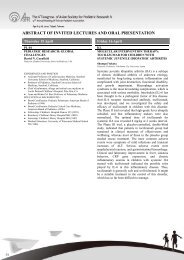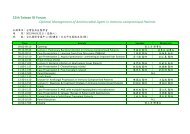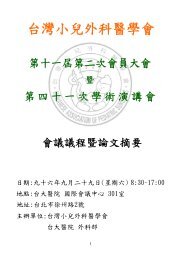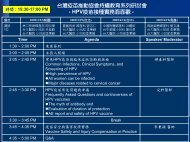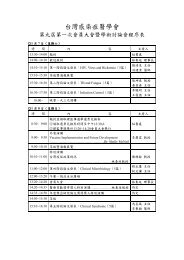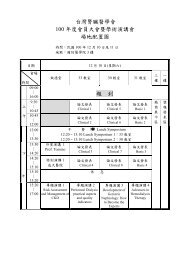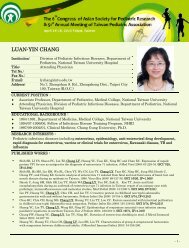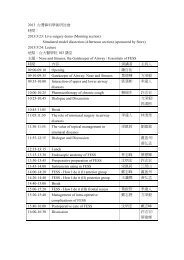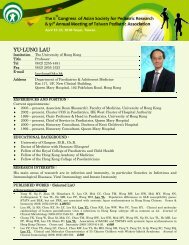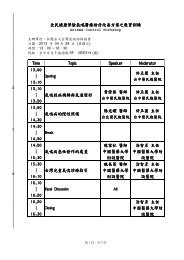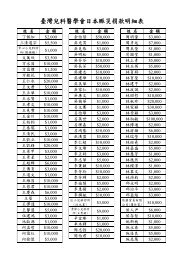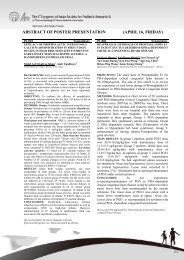ABSTRACT OF POSTER PRESENTATION (APRIL 17, SATURDAY)
ABSTRACT OF POSTER PRESENTATION (APRIL 17, SATURDAY)
ABSTRACT OF POSTER PRESENTATION (APRIL 17, SATURDAY)
Create successful ePaper yourself
Turn your PDF publications into a flip-book with our unique Google optimized e-Paper software.
P2-059 Neuropsychiatry (Neurology) P2-060 Neuropsychiatry (Neurology)DIETARY RESTRICTION REDUCED BRAINDAMAGE CAUSED BY NEONATALHYPOXIC-ISCHEMIA THROUGH INSULININTRAVENOUS VALPROIC ACID FORCONTROL <strong>OF</strong> STATUS EPILEPTICUS INCHILDREN: A META ANALYSISSIGNALING PATHWAYYi-Fang Tu 1,2 , Pei-Jung Lu 1 , Chao-Ching Huang 1,31 Graduate Institute of Clinical Medicine, National Cheng Kung UniversityCollege of Medicine, Tainan, Taiwan;Departments of 2 Emergency Medicineand 3 Pediatrics, National Cheng Kung University College of Medicine andHospital, Tainan, TaiwanOBJECTIVE: Neuroplasticity altered by perinatalprogramming may aggravate or protect againstneonatal hypoxic-ischemia (HI) brain injury. Weexamined whether metabolic plasticity induced bydietary restriction (DR) during the early lactationperiod provided neuroprotection against HI inneonatal rats through insulin signaling pathway.METHODS: Sprague-Dawley pups were groupedfrom postnatal day (P) 1: normal birth litter size (NL)rats (12pups/dam) and DR rats (18 pups/dam). OnP7, pups were subjected to HI induced by modifiedRice-Vannucci model. Outcomes and signalingpathways were investigated. In vitro study, theoxygen glucose deprivation (OGD) model inhippocampal neuronal cells H19-7 was established tofurther prove the causal signaling pathways.MAIN RESULTS: DR rats significantly reducedbody weight and brown and white adipose tissue onP7. After subjecting to HI on P7, post-HI DR ratsreduced TUNEL-positive cells andapoptosis-associated proteins (caspases and Poly(ADP-ribose) polymerase). The adult post-HI DRrats behaved significantly better learning ability andhad less brain-volume loss than adult post-HI NLrats. The level of insulin receptor substrate-1 (IRS-1)in insulin signaling pathway was noted to bepreserved in post-HI DR rats and degraded inpost-HI NL rats. It leaded to activate PI3K/Aktpathway in post-HI DR rats. Over-expression andknockdown of IRS-1 in H19-7 caused increased anddecreased cell viability after OGD, respectively.Knockdown of IRS-1 further reduced the activationof PI3K/Akt and increased the level of cleavedcaspase 3.CONCLUSION: Metabolic plasticity induced byDR during the early lactation period providesneuroprotection against neonatal HI brain injurythrough insulin signaling pathway.[Keywords] Dietary Restriction, Neonatal Hypoxic-ischemiaEncephalopathy, Insulin Receptor Substrate-1Pamela T. Roxas, M.D.De La Salle University Health Sciences Institute, Dasmarinas Cavite, PhilippinesOBJECTIVE: The primary outcome is to establish theefficacy and safety of intravenous valproic acid incontrolling status epilepticus in children aged 3 monthsto 18 years old.METHODS: A search was done in Medline, Pubmed,Cochrane, EMBASE, CENTRAL using the Mesh terms"status epilepticus", " prolonged seizures", " intravenousvalproic acid", "valproic acid", "intravenous sodiumvalproate", "sodium valproate" and "children" for trialspublished from 1990-2009. Cross reference withbibiliogaphies, search for unpublished and local trials wasdone. Randomized controlled trials on the use ofintravenous valproic acid versus another anti epilepticdrug for control of status epilepticus in children ages 3months to 18 years old were included. Data wereextracted independently and quality of included trialswere assessed independently using standard forms. Datawas analyzed using Review Manager 5.MAIN RESULTS: A total of 3 randomized controlledtrials and population of 208 subjects were included.Intravenous valproic acid is 76.63% effective incontrolling status epilepticus in children. (OR= 0.49,95% CI 0.23 to 1.04, p=0.06) Loading dose of20-40mg/kg and infusion rates of 2-5 mg/kg/min wasused. Its safety is well tolerated with a statisticallysignificant freedom from adverse events of respiratorydepression (OR=0.10, 95% CI 0.02 to 0.04) andhypotension (OR= 0.06, 95% CI 0.01 to 0.32).However, elevation in liver enzymes was thrice morelikely in treated patients (0R 3.08, 95% CI 0.71 to13.29). Breakthrough seizures for 6 hours from initiatonof treatment was 5% less likely for the valproic acidtreated children. (OR 0.95, 95% CI 0.41 to 2.16)Neurologic outcome and mortality did not differ betweenthe two groups.CONCLUSION: Intravenous valproic acid is effectivefor control of status epilepticus in children and may be abetter alternative for those at high risk for adverse eventswith the first line drugs and for refractory cases.[Keywords]status epilepticus, children, valproic acid, sodiumvalrproate284



